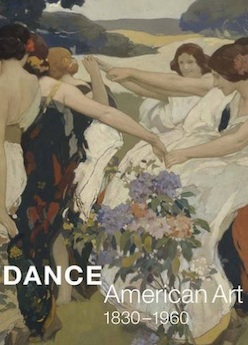By Corey Wronski-Mayersak
Dance: American Art, 1830-1960 breaks new intellectual ground in exploring what editor Jane Dini calls “the fundamental connections of dance and its representation.”
The collection was released in connection with the exhibition Dance: American Art, 1830-1960, which opened at the Detroit Institute of Arts in March 2016 and will tour through January 2017. But the book is not merely a catalogue of the exhibition pieces or a coffee table art book. Rather, it is a collection of thirteen theoretical essays presenting unique interpretations of dance as a subject of American visual art. Contributors include both art historians and dance historians, each drawing from their respective fields but working across disciplinary lines to examine how the depiction of dance in art can provide a window into historical moments.
The scope is decidedly broad: images of dance provide insight into politics, class divisions, changing industry, interracial tensions, and shifting gender mores throughout the nineteenth and twentieth century. The book also encourages a wide view of “dance” itself: depictions of social dance and of casual frivolity are analyzed alongside images of professional performances of romantic ballet and early modern dance.
A few stand-out chapters from among the thirteen diverse essays are particularly timely and demonstrate the work’s depth of insight into cultural issues and historical moments.
Certainly worthy of special mention is the opening essay by Constance Valis Hill, “In the Eye of the Beholder: The Black Presence in the Art of American Dance.” Hill compares depictions of white and black social dance in the nineteenth-century, while also examining what she sees as the centrality of black musicians in the home entertainments of antebellum white households. Her analysis demonstrates a sometimes fraught but ever-present dependence; Hill explains how evidence from art shows that “one could not tell a story about American sociability without telling the story of black musicality.”
One of Dini’s own contributions to the collection, “The Art of Dancing Out of Doors,” brilliantly weaves together two histories and demonstrates their parallels: the history of images of dancers in natural settings and the history of demographic changes in late nineteenth-century America. She highlights the relation between forms of folk dance and immigration, dance as cultural activity and as a part of “becoming American,” and perceptions of the foreigner. In its attention to tensions surrounding immigration and their expression in art, the essay is exceptionally timely today despite Dini’s focus on an earlier historical period. Dini also reflects on the representation of the female dancing body and its relation to new forms of women’s empowerment in the late nineteenth and early twentieth-century.
The penultimate essay in the collection, “Immortal Dancers: Joseph Cornell’s Pacifism During the Second World War,” by Analisa Leppanen-Guerra, offers one of the best examples of how the book illuminates connections between dance, art, and politics. Leppanen-Guerra describes the World War II-era collages and mixed media art of Joseph Cornell as response to their time, examining how Cornell’s art features ballet as a symbol of peace and a representation of an alternative world, a world of the heavens and the spirit rather than the horrors of war.
With a list price of $55, the book is certainly a significant investment rather than a casual read. But given the large size, range of material, and 230 full-color plates, the cost is not unreasonable for the product. Moreover, in its wide-ranging and interdisciplinary connections, aiming to offer what Dini describes as “a true collaborative study between the fine and performing arts,” it is a model of the vitality and power of liberal arts inquiry.
Corey Wronski-Mayersak (ΦBK, Goucher College, 2002) is an Assistant Professor of English at McDaniel College and a resident member of the Delta of Maryland chapter of Phi Beta Kappa.




